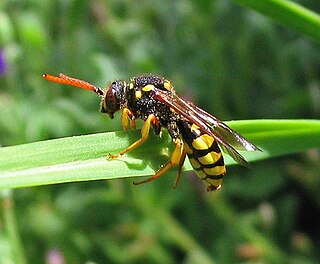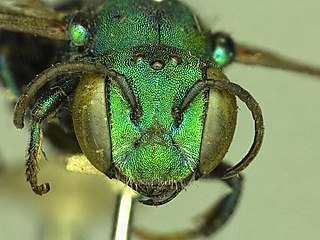
Cucurbita pepo is a cultivated plant of the genus Cucurbita. It yields varieties of winter squash and pumpkin, but the most widespread varieties belong to the subspecies Cucurbita pepo subsp. pepo, called summer squash.

The geometer moths are moths belonging to the family Geometridae of the insect order Lepidoptera, the moths and butterflies. Their scientific name derives from the Ancient Greek geo γεω, and metron μέτρον "measure" in reference to the way their larvae, or "inchworms", appear to "measure the earth" as they move along in a looping fashion. A very large family, it has around 23,000 species of moths described, and over 1400 species from six subfamilies indigenous to North America alone. A well-known member is the peppered moth, Biston betularia, which has been subject of numerous studies in population genetics. Several other geometer moths are notorious pests.

Atta texana is a fungus-farming ant species of the genus Atta, found in Texas, Louisiana, and northeastern states of Mexico. Common names include town ant, parasol ant, fungus ant, Texas leafcutter ant, cut ant, and night ant. It harvests leaves from over 200 plant species, and is considered a major pest of agricultural and ornamental plants, as it can defoliate a citrus tree in less than 24 hours. Every colony has several queens and up to 2 million workers. Nests are built in well-drained, sandy or loamy soil, and may reach a depth of 6 m (20 ft), have 1000 entrance holes, and occupy 420 m2 (4,500 sq ft).

The surfbird is a small stocky wader in the family Scolopacidae. It was once considered to be allied to the turnstones, and placed in the monotypic genus Aphriza, but is now placed in the genus Calidris.

Betula lenta is a species of birch native to eastern North America, from southern Maine west to southernmost Ontario, and south in the Appalachian Mountains to northern Georgia.
The Tropas Nómadas were an auxiliary regiment to the colonial army in Spanish Sahara, from the 1930s until the end of the Spanish presence in the territory in 1975. Composed of Sahrawi tribesmen, the Tropas Nómadas were equipped with small arms and led by Spanish officers, guarding outposts and sometimes conducting patrols on camelback.

With over 850 species, the genus Nomada is one of the largest genera in the family Apidae, and the largest genus of kleptoparasitic "cuckoo bees." Kleptoparasitic bees are so named because they enter the nests of a host and lay eggs there, stealing resources that the host has already collected. The name "Nomada" is derived from the Greek word nomas, meaning "roaming" or "wandering."

The genus Megachile is a cosmopolitan group of solitary bees, often called leafcutter bees or leafcutting bees; it also includes the called resin bees and mortar bees. While other genera within the family Megachilidae may chew leaves or petals into fragments to build their nests, certain species within Megachile neatly cut pieces of leaves or petals, hence their common name. This is one of the largest genera of bees, with more than 1500 species in over 50 subgenera. The introduced alfalfa leafcutter bee is managed for crop pollination in various regions around the world.

The Texas brown snake(Storeria dekayi texana), a subspecies of Storeria dekayi, is a nonvenomous snake in the family Colubridae. It is endemic to North America.
Ezra Townsend Cresson, also Ezra Townsend senior was an American entomologist who specialised in the Hymenoptera order of insects. He wrote Synopsis of the families and genera of the Hymenoptera of America, north of Mexico Philadelphia: Paul C. Stockhausen, Entomological printer (1887) and many other works. His son Ezra Townsend, Jr. (1876–1948) was also an entomologist but a specialist in Diptera.

Exomalopsis is a genus of bees in the family Apidae. They occur in the Western Hemisphere.

Coelioxys sodalis is a bee from the family Megachilidae, one of numerous kleptoparasitic bees in the tribe Megachilini. Members of the genus Coelioxys exhibit kleptoparasitic behavior in that they lay their eggs in the nests of other bees, typically those of the related genus Megachile. As this behavior is similar to that of cuckoos, such bees are referred to as cuckoo bees. These host-parasite relationships are complex Host insects of the brood parasite C. sodalis include Megachile melanophaea, M. texana, and M. rotundata.

Megachile texana, the Texas leafcutter bee, is a species of bee in the family Megachilidae. It was first described by the American entomologist Ezra Townsend Cresson in 1878. It is native to the United States and southern Canada.

Macrotera is a genus of bees native to North America, particularly diverse in the desert regions of the United States and Mexico. According to Wilson and Carril, there are "around 30" species of Macrotera. Macrotera are small to medium sized and often black or reddish in coloration. The genus was treated by P.H. Timberlake who, in addition to T.D.A. Cockerell, described most of the known species. Macrotera used to be considered part of the genus Perdita but was split apart by C.D. Michener in 2000. Most species are extreme specialists (oligoleges) with respect to pollen and will only collect pollen from a few closely related species or genera of plants, particularly the plant genus Sphaeralcea and various Cactaceae.

Nomada marshamella, Marsham's nomad bee, is a species of Palearctic cuckoo bee which appears to be a wasp mimic and which is cleptoparasite on the mining bees of the genus Andrena, especially A. scotica and A. trimmerana.

Andrena vaga, the grey-backed mining bee, is a species of solitary bee which is found in most of Europe but which is very rare in Great Britain, where it may be recolonizing in the south-east after previously being extirpated. It specialises in feeding on the pollen of willows.

Osmia foxi is a species of mason bees in the family Megachilidae. It is found in New Mexico and southeastern Arizona in the United States and in Sonora, Mexico.
Neofidia texana is a species of leaf beetle that is found in North America. It occurs in central and east-central Texas, and is associated with plants in the grape family (Vitaceae). Neofidia texana was first described as a variety of Fidia viticida by the American entomologist Charles Frederic August Schaeffer in 1934. It is now considered to be a separate species.

Andrena wilkella, also known as Wilke's mining bee, is a species of miner bee in the family Andrenidae. Its original distribution is Europe. It has been accidentally introduced to North America long ago, possibly with ship ballast. It is active between April and August. Andrena wilkella has been recorded to nest both singly and in aggregations. Andrena wilkella preferentially collects pollen from Fabaceae including clover and sweet clover.

Chelostoma campanularum, or the harebell carpenter bee, is a species of hymenopteran in the family Megachilidae. It is found in Europe and Northern Asia and North America.

















